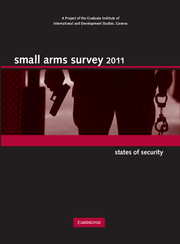Book contents
- Frontmatter
- Foreword
- Contents
- About the Small Arms Survey
- Notes to readers
- Acknowledgements
- Introduction
- Chapter 1 Larger but Less Known: Authorized Light Weapons Transfers
- Chapter 2 Fact or Fiction?: The UN Small Arms Process
- Chapter 3 Procurement and Policy: Police Use of Emerging Weapons Technology
- Chapter 4 A Booming Business: Private Security and Small Arms
- Chapter 5 Protected but Exposed: Multinationals and Private Security
- Chapter 6 Ethos of Exploitation: Insecurity and Predation in Madagascar
- Chapter 7 Reforming the Ranks: Public Security in a Divided Côte d'Ivoire
- Chapter 8 Securing the State: Haiti before and after the Earthquake
- Chapter 9 Balancing Act: Regulation of Civilian Firearm Possession
- Index
Chapter 8 - Securing the State: Haiti before and after the Earthquake
Published online by Cambridge University Press: 05 March 2012
- Frontmatter
- Foreword
- Contents
- About the Small Arms Survey
- Notes to readers
- Acknowledgements
- Introduction
- Chapter 1 Larger but Less Known: Authorized Light Weapons Transfers
- Chapter 2 Fact or Fiction?: The UN Small Arms Process
- Chapter 3 Procurement and Policy: Police Use of Emerging Weapons Technology
- Chapter 4 A Booming Business: Private Security and Small Arms
- Chapter 5 Protected but Exposed: Multinationals and Private Security
- Chapter 6 Ethos of Exploitation: Insecurity and Predation in Madagascar
- Chapter 7 Reforming the Ranks: Public Security in a Divided Côte d'Ivoire
- Chapter 8 Securing the State: Haiti before and after the Earthquake
- Chapter 9 Balancing Act: Regulation of Civilian Firearm Possession
- Index
Summary
INTRODUCTION
On 12 January 2010, a devastating earthquake killed an estimated 158,000 people in Haiti's capital, Port-au-Prince, and displaced 1.3 million more. In its wake, the nation's first cholera epidemic killed more than 3,700 and infected another 185,000. The international community pledged more than USD 10 billion towards rebuilding the country. As of January 2011, however, less than one-tenth of this sum had been disbursed in Haiti.
The costs of the natural disaster extended well beyond death and injury. Port-au-Prince and surrounding towns were left in ruins. Virtually every government building was damaged, and many civil servants–including police officers–were killed. Wary of the potential for escalating crime and violence in the capital, multilateral agencies, regional organizations, and bilateral donors rapidly focused on promoting increased policing capacities and wider security sector reforms.
The international focus on improving security sector capacity in Haiti is not new. Since declaring independence 200 years ago, the country has contended with periodic outbursts of political violence and international efforts to influence Haitian governance through the establishment of structural adjustment programmes and reform of the justice, military, policing, and corrections systems. In spite of billions of dollars poured into enhancing conventional security promotion, these approaches are routinely criticized for generating marginal returns in terms of improved safety on the ground in Haiti.
- Type
- Chapter
- Information
- Small Arms Survey 2011States of Security, pp. 229 - 260Publisher: Cambridge University PressPrint publication year: 2011
- 2
- Cited by



